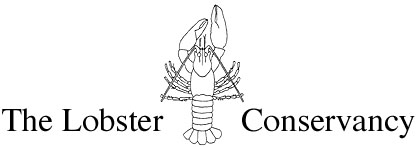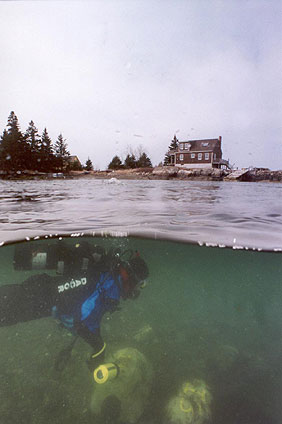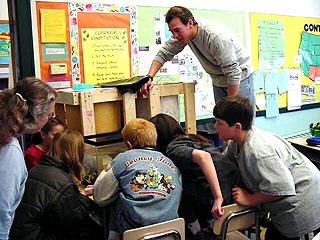
P.O. Box 235, Friendship, ME 04547 (207) 832-8224 www.lobsters.org

P.O. Box 235, Friendship, ME 04547 (207) 832-8224 www.lobsters.org
April 9, 2002
Dear Volunteers and Friends of The Lobster Conservancy,
For those of you who may be unfamiliar with The Lobster Conservancy, we are primarily a scientific research organization dedicated to sustaining a thriving lobster fishery through science and community. This newsletter keeps our friends and volunteer research team informed of our activities. Here's what we've been up to over the past few months.News from the Board of Directors
The Lobster Conservancy is growing by leaps and bounds. We are thankful for support of this year's programs by Darden Environmental Trust, Davis Conservation Foundation, Greater Piscataqua Community Foundation, Island Institute, MBNA, Maine Community Foundation, Maine Sea Grant, National Fish and Wildlife Foundation and Up East, Inc. Also, thank you to the individuals and businesses who have responded to our Annual Appeal. Thanks to such support, there are now seven of us focused on TLC projects on a daily basis. These new faces (some of whom can already be seen on our staff web page www.lobsters.org/people/staff.html) are:
Dan O'Grady is an Island Institute Fellow placed with TLC. The Island Institute Fellows Program is designed to provide support to island and coastal communities through the efforts of recent college graduates who want to serve in these communities while gaining valuable field experience. Dan received a BA in biology from Colby College in 1993 and an MS in zoology from The University of New Hampshire in 2001. His Master's thesis dealt with the physiology and behavior of adult lobsters, and during his graduate school career Dan participated in fishery-related lobster research with his advisor, Dr. Winsor Watson III. Dan started with TLC in January and is interested in both education and research. Last week, the education project that he and Linda Archambault developed - to raise larval lobsters at the Friendship Village School - was funded by MBNA. Dan is also working at the office, the Lobster Life Studies Center, and on the Juvenile Lobster Project.
Linda Archambault is TLC's Research and Education Coordinator. Linda received her Master's degree in Marine Biology from Boston University Marine Program in 1986. After college she worked in the laboratory of Dr. Jelle Atema at the Marine Biological Laboratory in Woods Hole, where she studied the feeding behavior and related neurophysiology of lobsters. Since then Linda has been raising her two children, running a small business out of her home, and volunteering for school and community organizations. Last spring, Linda participated in the first Mid-Coast Stewards course, put on by the Maine Coastal Program and Knox-Lincoln Soil and Water Conservation District. Since then, she has been volunteering for TLC at the Lobster Life Studies Center and for Earthways, an education program of the Pemaquid Watershed Association. At TLC, Linda will coordinate research for a long-term comparative study of three lobster nursery sites and work with Dan O'Grady on the Lobster Literacy Program.
John Guarnaccia has signed on part-time as Director of Institutional Development. John is a specialist in organizational development, fund raising, and program development for conservation oriented non-profit organizations. He knows the Gulf of Maine marine resource field well, having served two and a half years as Development Director for the Island Institute. He served for seven years as Executive Director of RARE Center for Tropical Conservation. We had a great experience working with John before when he facilitated TLC's Strategic Planning Retreat in April 2001.
Jane Roundy is donating time as Volunteer Coordinator for the Juvenile Lobster Monitoring Program. Jane has been a JLMP volunteer since 1998, and is now expanding her duties to bring a volunteer's perspective to the JLMP training and sampling process. Jane has been doing a tremendous job updating our volunteer training manual and developing our Volunteer Certification Program for the start of the monitoring season.
In January, Jill Laramee served as a winter intern. Jill is a biology major at Colby College in Waterville, Maine, who hopes to pursue a career in marine science. Jill spent her previous semester abroad at James Cook University in Townsville, Australia where she studied biology and considers herself lucky to have had the opportunity to snorkel and dive on the Great Barrier Reef. At TLC, Jill proofread and updated the extensive JLMP database and pitched in with other duties as needed. Best wishes with your on-going studies, Jill.
It is a great pleasure working with these talented and dedicated people.
On a sadder note, Friendship Long Island resident and TLC supporter Stark Whitley passed away suddenly in March. You will be missed, Stark.
Research News
Juvenile Lobster Project
We are pleased to announce the publication of two peer-reviewed scientific papers, which were originally presented at the Sixth International Conference and Workshop on Lobster Biology and Management in September 2000:
Cowan, D.F., A.R. Solow, and A. Beet. 2001. Patterns in abundance and growth of juvenile lobster, Homarus americanus. Marine and Freshwater Research 52: 1095-1102 Ellis, S.L. and D.F. Cowan. 2001. Volunteer-based monitoring of juvenile American lobster, Homarus americanus.Marine and Freshwater Research 52:1103-1112.
The first paper examines patterns of growth and abundance of juvenile lobsters in the wild, based on Diane's long-term tag-and-recapture studies at Lowell's Cove from 1993-1999. The second paper describes our volunteer-based Juvenile Lobster Monitoring Program (JLMP) and presents preliminary results of data collected by volunteers in Maine, New Hampshire and Massachusetts between 1997 and 2000. We plan to distribute the second paper to all JLMP volunteers, past and present. If you would like copies of either of these papers, please let us know.
Volunteer Programs
We are busily preparing for our 7th year of volunteer-based sampling in the Juvenile Lobster Monitoring Program, which begins in late May. We will be holding Season Kick-Off meetings this weekend in Friendship, Maine on April 13 and Rye, New Hampshire on April 14 to touch base with volunteers. Thank you to the Hahn Community Center and the Seacoast Science Center for providing space for these events. At the Season Kick Off meetings, we will give volunteers copies of our latest publication, provide an updated version of the monitoring handbook, test equipment to make sure everything is ship shape, and run through our new Volunteer Certification Program. We will also debut our new Volunteer Training Video, produced by film-makers Alex and Martha Loer of Pier 8 Pictures.
Long-term Tagging of Juvenile Lobster
Diane has continued year-round long-term tag-and-recapture studies of juvenile lobsters at Lowell's Cove on Orr's Island in Casco Bay, where she is entering her 10th year of sampling, and at Deep Cove on Friendship Long Island in Muscongus Bay, where she is entering her 4th study year. At Lowell's Cove, there were low densities of lobsters in December and January, but higher densities in February and March. At Deep Cove, densities of juvenile lobsters have remained low all winter, but started picking up in March.
Lobster Life Studies Center
Last November, film-makers Nick Caloyainis and Clarita Berger went diving with Diane in the research pound at the Lobster Life Studies Center to take video and still photos. You may recognize Nick and Clarita's names as film-makers of the award-winning "Realm of the Lobster" (www.movieodysseys.com). They plan to come back to the LLSC in April to help us set up a video lobster surveillance system. While here, Nick will be giving a slide show of marine images entitled "Sharks and Treasures" at the Hahn Community Center in Friendship, Sunday April 14, 7:00-8:00 pm.

Diane observing activity around lobster shelters in the waters of the LLSC. (Photo by Nick Caloyianis)
In a pilot video project, Diane and Dan installed an underwater video surveillance system in the pound at the LLSC in February. The system consists of an underwater camera attached via cable to a buoy floating on the surface. The buoy contains three 12-Volt batteries (each the size of a brick), an electronic timer, and a transmitter that sends the video signal to a receiver on shore. The signal is recorded on a time-lapse VCR and displayed on a TV monitor. The plan is to use this type of system to observe the courtship and mating behavior of adult lobsters in the pound this summer and compare what we see to the results of laboratory studies that Diane has done in Woods Hole. Thank you to Professor Win Watson, from University of New Hampshire, for the loan of the prototype video system.
In a related study, TLC plans to map the areas within Muscongus Bay where female lobsters spawn (extrude their eggs onto their tail) and hatch their eggs by tracking the movements of egg-bearing females. Two different tags will be used to track these females. The first is a simple external tag; we will ask lobstermen to report to us when and where they captured the lobster and what condition the eggs were in. The second tag is a sonar tag that emits a series of ultra-high frequency beeps that can be detected with an underwater microphone. This will allow us to determine where these lobsters are without having to recapture them. A preliminary study is already underway at the LLSC, where we have attached a sonar tag to one female lobster and are keeping track of her movements within the pound.
Outreach and Education
Over the years, TLC scientists and volunteers have participated in an informal education program by giving presentations at public forums and schools. To formalize our education program we are launching a Lobster Literacy Program. The overall goal of the project is to increase students' environmental literacy, particularly with regard to lobsters and the marine environment.

Island Institute Fellow and TLC staffer Dan O’Grady brings lobster biology to life at the Friendship Village School. (Photo by Carla Eutsler)
Our first objective is to bring the Lobster Literacy program to public schools, beginning with the Friendship Village School in Friendship, Maine. "Lobster Larvae in the Classroom," which is being led by Dan O'Grady and Linda Archambault, is a two-month project involving the students in Carla Eutsler's fourth through sixth grade science classes. Students will raise lobsters in their classroom from the point at which they hatch from eggs, through three swimming larval stages, until they reach the fourth or settlement stage. During this hands-on learning experience, the students will monitor water quality in the larval tanks, raise brine shrimp to feed to the larval lobsters, and track the growth and development of the lobsters. They will also go on two field trips. The first field trip will be led by Sarah Gladu of the University of Maine Cooperative Extension to collect and view the planktonic organisms that larval and postlarval lobsters feed on in the wild. The second trip will be a trip to the rocky intertidal zone, where students will learn about the habitat of juvenile lobsters, discover some juvenile lobster predators and prey, and learn about TLC's Juvenile Lobster Monitoring Program. We plan to expand the program to other schools in coming years. Thank you to MBNA's Maine Excellence in Education Grants Program for supporting this educational initiative.
TLC is continuing to partner with Bowdoin College's service-learning programs. This semester, students from Professor Ed Laine's Geometrics class are working on two projects for TLC. The first is to update a GIS-based map of TLC's lobster monitoring sites in Maine to create an interactive map that is linked to data on lobster abundance. The second project will be to survey the research lobster pound at the Lobster Life Studies Center to create a GIS-based map that includes bottom contours, substrate type, and locations of lobster shelters. In preparation for these projects, Diane led a class discussion with the Geometrics students in February.
In March, TLC set up an information booth at the trade show of the Maine Fishermen's Forum. This was a great opportunity for us to spread the word about TLC programs, to catch up with old friends, and make new connections. Thank you to Dan O'Grady and the Island Institute for creating two informative posters. Thanks also to Linda Archambault and Pen Bay Stewards Leah Clem, Joan & Maynard Clement, Gene Scarl, Gary Roberts, Bob Stanley, and Sonia Spalding for volunteering to man the booth, to Lorraine Lessard and Theresa Torrent-Ellis for mobilizing these "troops," and to Lucille Blackler for logistical support. It was a pleasure to see all of you who stopped by to say hello. Congratulations to Bob and Diane Williams of Stonington, Maine, winners of our T-shirt drawing.
Also at the Forum, Diane participated in a panel discussion entitled "Predicting Future Lobster Landings," along with Rick Wahle and Lew Incze of Bigelow Lab and Bob Steneck of University of Maine. Presentations by Wahle and Steneck focused on declining abundances of juvenile lobsters from 1997 to 1999, and their resulting predictions that the lobster catch will soon decline. Diane presented data collected over a nine-year sampling period at Lowell's Cove. Analyses of the Lowell's Cove data set by Diane and statisticians from Woods Hole Oceanographic Institution do not indicate an overall upward or downward trend in abundance of recently-settled lobsters. These differing results led to a discussion among scientists and the public. (See two newspaper articles at www.lobsters.org/press/press.php for summaries of these panel presentations.)
Press Coverage
As hinted at above, TLC has been the subject of much media coverage over the past several months (see www.lobsters.org/press/press.php). In March, there were two articles that covered the panel discussion at the Maine Fishermen's Forum in which Diane participated:
"Scientists Aid Lobstermen in Predicting Fishery's Future." Bangor Daily News, March 4, 2002, and "Scientists Expect Decline in Lobster Landings." The Courier Gazette, Tuesday, March 5, 2002.
Another area of concern for Maine lobstermen is that many coastal towns are considering spraying the pesticide Dimilin to combat Browntail moths. This pesticide in known to be toxic to lobsters, through its effect on shell development, thus it is wise for towns to fully weigh the risks versus benefits of spraying, before launching such a program. Diane presented her views at Harpswell Town Meeting on March 9 on the risks of spraying Dimilin. She was also quoted in three articles, and wrote an article on the subject in the April's Lobster Doc column:
"Harpswell Lobstermen See Pesticide as Threat." Portland Press Herald, March 4, 2002, and
"Browntail Wagging the Dog?" Harpswell Anchor, February/March 2002,
"The Ultimate Shell Game: Browntails or Lobsters." The Casco Bay Bulletin, Spring 2002.
"Lobsters and Insecticides." Commercial Fisheries News, April 2002.
Other Lobster Doc columns that Diane wrote this year for Commercial Fisheries News were, "Female lobsters of Grand Manan." January 2002, "Part I: Lobster Mating Trials." February 2002, and "Part II: More Males than Females." March 2002. All three of these articles focused on reproductive behavior of adult lobsters. In April, Diane's work on courtship behavior in lobsters was part of a larger piece on lobster science, entitled:
"Stalking the American Lobster." The Atlantic Monthly, by Trevor Corson.
As you can see we've been keeping busy over the past several months. We're looking forward to another exciting and productive year.
Yours in TLC and Friendship,
Sara Ellis, Executive Director and Diane Cowan, Senior Scientist